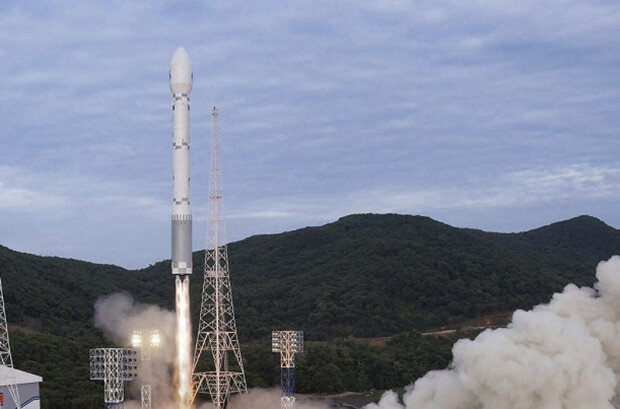Pyongyang aims to launch multiple spy satellites
Pyongyang aims to launch multiple spy satellites
Posted June. 02, 2023 08:02,
Updated June. 02, 2023 08:02

It was found that the Chollima-1, a North Korean satellite launch vehicle that crashed into the waters on Wednesday, features a larger part for satellite loading than the Kwangmyongsong fired by the regime in February 2016. According to analysts, it was presumed that attempts were made to launch multiple reconnaissance satellites at one go targeting South Korea and the United States. This three-stage carrier rocket is larger than the Kwangmyongsong in total length. Also, it is reported that the failed Chollima-1 is equipped with two to four Baekdusan engines designed for intercontinental ballistic missiles. South Korean military authorities spotted the rocket's fuselage, including a second-stage propulsion system, among the broken pieces that fell after its first stage was separated the previous day. They have since worked to recover them from the sea.
The Chollima-1 appeared greatly different from the Kwangmyongsong based on images released by the Korean Central News Agency (KCNA) on Thursday showing the previous day's rocket lift-off. Compared to the latter, the diameter of which gets smaller gradually from the first stage through to the third-stage part, with the satellite loading section at the top being of the smallest scale, the former has almost the same diameter up to the third-stage part but has an outstandingly enlarged part for satellite loading. Former President of the Korea Aerospace Research Institute Kim Seung-jo analyzed that the satellite section could have been scaled up due to its practical use, or the larger scale could have been associated with the regime's attempts to carry multiple satellites at once.
According to the military and related experts, the total length of the Cheollima-1 exceeds 30 meters, slightly longer than the 29-meter-long Kwangmyongsong. It is assumed that the regime developed a larger system in terms of length and other measurements to accommodate heavier satellites. Added to this, the Baekdusan engine on liquid fuel was applied to enhance propulsion compared to the Kwangmyongsong equipped with four Rodong missile engines for a mid-range distance. The former was used for Pyongyang’s ICBMs, including the Hwasong-17, which was verified via multiple test launches.
The 15-meter-long fuselage, including the second-stage part, was found around 200 kilometers west of Eochengdo in Gunsan, North Jeolla Province, where the space launcher fell on Wednesday. The South Korean military has worked to bring it up to the surface. The vessel Tongyeong ATS-31, the vessel APL Gwangyang, and the Special Security Unit were deployed during the recovery mission.
This massive fuselage, reportedly as long as more than half the total carrier rocket, floated to the surface in the previous day but sank 75 meters down the sea bottom as of Thursday. The first-stage part, the third stage, including the satellite loading part, and the satellite are assumed to have fallen around the waters. Once the ongoing recovery mission is successfully completed, it will help take a closer look at the technologies and performance of this North Korean satellite launch vehicle, in effect, an ICBM, according to the South Korean military.
Hyo-Ju Son hjson@donga.com
Headline News
- Israel prepares for retaliation against Iran
- Samsung reclaims top spot, surpassing Apple in smartphone market
- 77% of Koreans in 20s and 30s are 'Kangaroo Tribe' due to job crisis
- KBO referees embroiled in controversy over ABS decision concealment
- Inflation, oil price surge put double shock on global economy






